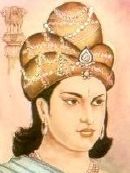
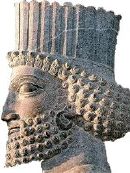 If you think it was the MMA who tried to introduce the “law of morality” in the Frontier province of Pakistan (NWFP), think again!
If you think it was the MMA who tried to introduce the “law of morality” in the Frontier province of Pakistan (NWFP), think again!
A “law of morality” was first introduced in the region much, much before the MMA or the Taliban appeared on the scene. Even before Pakistan, before the British and before the Moguls. And even before Islam – and before Jesus!
It was Emperor Ashoka (died 238 BC) who first introduced what he called the “Law of Piety” sometime in the third century BC. He even introduced “moral agents”, the equivalent of the MMA’s proposed “vice and virtue squads”, to enforce his Law of Piety.
There were important differences, though, between Ashoka’s Law of Piety and MMA’s Hasba Bill and their methods of enforcement. But that is not the subject of this post. The post is about the presence of Emperor Ashoka and his “Rock Edicts” in the NWFP, the geographic backyard of Pakistan where innumerable treasures from the past are dumped by history.
I guess the readers at ATP would know from their history books that Ashoka was a grandson of Chandra Gupta Mauria and the third king of the Mauria dynasty. His empire, with its capital at Patna (Pataliputra), in Eastern India, extended up to and including the present day Afghanistan.
After a particularly bloody war in Kalinga (Orissa), Ashoka renounced all kinds of violence and converted to Buddhism. He even started propagating Buddhism actively. He formulated what was called the Law of Piety, a set of rules of conduct and governance, and started enforcing it throughout his empire. In the absence of any means of mass communication, he disseminated his message by edicts inscribed in the language of the time, which has been variously named as Brahmi, Kharoshthi and Pali, upon rock surfaces and pillars of polished sandstone. These rocks and pillars stood by the major highways of Ashoka’s empire.
After Ashoka‘s death the Maurian empire fell apart and, except in Buddhist circles where he was remembered as a great patron of the faith, Ashoka was largely forgotten both by history and Indian tradition.
It was only in the mid nineteenth century when a large number of rocks and pillars bearing Ashoka’s edicts came to light. The rocks and pillars were discovered at sites spread across Northern India, Nepal, Pakistan and Afghanistan.
A British researcher, James Princep (d 1838), painstakingly translated these inscriptions into English. It was through these translations that the world rediscovered Ashoka and came to the conclusion that he was a great king. H.G. Wells describes him in these words:
In the history of the world there have been thousands of kings and emperors who called themselves ‘their highnesses,’ ‘their majesties,’ and ‘their exalted majesties’ and so on. They shone for a brief moment, and as quickly disappeared. But Ashoka shines and shines brightly like a bright star, even unto this day.
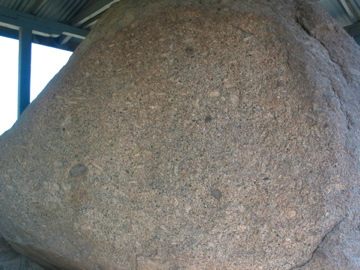 Of all the rock sites discovered two are in Pakistan, both in the NWFP, one in village Shahbaz Garhi, district Mardan and the other in Mansehra along the Karakuram Highway. (One site is Kandhar, Afghanistan and the remaining in Nepal and India.)
Of all the rock sites discovered two are in Pakistan, both in the NWFP, one in village Shahbaz Garhi, district Mardan and the other in Mansehra along the Karakuram Highway. (One site is Kandhar, Afghanistan and the remaining in Nepal and India.)
While the world rediscovered Ashoka in the mid 19th century, I discovered him, or rather his edicts, only last year when I stopped by at the “Ashoka’s Rocks” in Mansehra while on my way to Balakot. Actually, I had seen these rocks even before but was never able to read the translation of the edicts provided at the site. It was extremely difficult to read and unintelligible. I will explain shortly why.
The Ashoka’s rocks at Mansehra lie at a hillside along the Karakoram Highway. These are huge, grey, rounded granite boulders, few among the numerous similar boulders scattered all over the hill, which must have been deposited here many thousands of years ago, the result of a volcanic eruption or some other geologic event.
Only 3 rocks have the edicts engraved upon them, two in one place and one about 100 yards away across the highway.
Until the 1970s these rocks lay there exposed to the elements and humans. Other than a neglected signboard on the roadside that said “Ashoka inscribed rocks” and showed an arrow pointing to the hill, the rocks went largely unnoticed and unprotected.
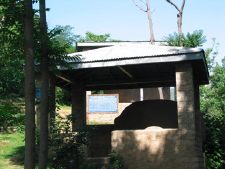
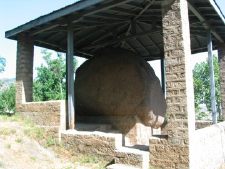
During the 1970s the Karakoram Highway was built following the footprints of the fabled and ancient silk route that connected the East with the West. The highway brought increased tourist traffic to the Northern Areas and, suddenly, it seems, the archaeology department woke up to the presence of the “Ashoka Rocks” in the area.
Mercifully, canopies were built over the rocks to protect them from the sun and the rain. They also built a gated enclosure around the rocks and, as if an afterthought, installed a signboard at the site giving an English translation of the edicts.
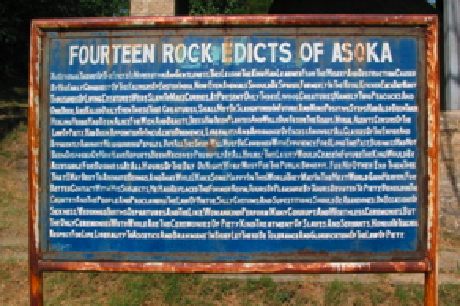
However, it seems, the person in charge of the project did not have enough money in the budget to provide a large enough board to accommodate the whole text of the edicts. Consequently, M. Shabbir Rahi (that was the name of the painter. I found it signed in a corner of the board), tried to squeeze the total text into the space available to him. He did this by writing the whole text (except the headline) as one continuous sentence by doing away with spaces between words.To complicate matters further, Mr. Rahi decided to capitalize the first letter of every word. This was his way of indicating a space between words. To further economize on space he even dropped words from some sentences making them incoherent and unintelligible. Now you know, why I was unable or unwilling to read the edicts on my earlier trips.
This time I made a determined effort to decipher the message on the board. I took a picture of the text, copied it on paper and then broke it into independent sentences. (I guess, translating from the original Brahmi or Pali text into English would not have been much more difficult.) Anyway, here is the result:
- The general theme of the edicts is moderation and gentleness. This lesson the king had learnt from the misery and destruction caused by his early conquests of Kalingas of Eastern India.
- Now even animals should be spared. Formerly, in the royal kitchen, each day, many thousands of living creatures were slaughtered to make curries. But now only three creatures, namely two peacocks and one deer, are killed daily, and deer not always. And in time, not even these three creatures will be killed.
- And more positive steps had also been taken. Healing herbs had been used alike for men and beasts. Trees had been planted and wells dug beside the roads.
- Moral agents, censors of the Law of Piety, had been appointed to inculcate obedience, liberty and avoiding excess among all classes of the empire and even amongst neighboring peoples.
- But all this goodwill must be combined with efficiency. For a long time past, business had not been disposed of, nor have reports been received promptly at all hours. The laxity would cease in future. The king would be available at all hours of the day or night. Work must be done for public benefit — for no other end than this.
- That I may debt to animate beings, and that while I may make some happy in this world they may in the next world gain heaven.
- For better contacts with his subjects, the king had replaced the former royal tours of pleasure by tours devoted to piety, beholding the country and the people and proclaiming the law of virtue.
- Silly customs should be abandoned. On occasions of sickness, weddings, births, deaths and the like womankind perform many corrupt and worthless ceremonies. But the only ceremonies worthwhile are the ceremonies of piety, kind treatment of slaves and servants.
- Honor to teachers, respect for life, liberality to ascetics and Brahmins.
- In brief, let there be tolerance and glorification of the Law of Piety.
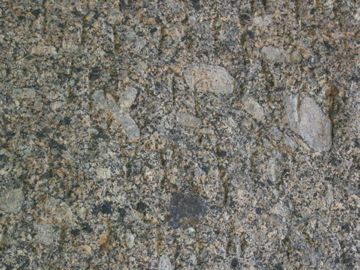 If there were a suggestion box at the site I would have liked to make three suggestions and ask a question. While the suggestions are addressed to the Archaeology Department or whoever looks after these rock sites, the question is addressed to whoever cares to answer.
If there were a suggestion box at the site I would have liked to make three suggestions and ask a question. While the suggestions are addressed to the Archaeology Department or whoever looks after these rock sites, the question is addressed to whoever cares to answer.
1. Please find a proper translation of the edicts and write them properly on a larger board. If necessary, use two boards. (You may use the services of M. Shabbir Rahi again, if he is still in business, but ensure that he uses conventional method of writing English.)
2. Also, show Urdu translation on a separate board for those who cannot read English.
3. And please do something (I am sure there must be a way) to protect the engraved letters from fading away. They are already weathered and barely visible.
Now the question: How come, this region, which has seen so many sires, sages, saints and soofis preach tolerance and non-violence, more than in any other part of the world, is faced with so much intolerance and violence?
Photo Credits: Map from here. Photographs of the site rock site itself by the author himself and can be seen here.



















































the sculpture of the bearded man looks Persian to me, not Indian. you know the ruins at Persepolis and the sculpture of King Cyrus the Great of Persia? it looks like that and has those features. please check.
Ashoka belongs to the rare humans of our glorious past who makes us pride to be his successor. He belongs to the period when there were neither communication nor conventioneer of high speed but just ruled because their subjects loved them. It is really interesting to learn that Fganistan and the West of Pakistan were part of Great Maurayan Empire as Chandragupta, the founder of Mauryan Empire married daughter of Seleucus Nectar the General of Alexander,s empire in Eastern World and he gifted four of his provinces to Chandragupta in dower. So it was totally peaceful transaction of South Asia,s big four regions into Mauryan kingdom. Ashoka’s son Kunal was governor of this region who letter became successor, but his stepmother queen injured his eyes and made blind. Later his son Samprati ruled here.
Pakistan and Afghanistan are greatest region of human kinds civilization. The Indus valley Culture, beginning first village and agriculture in through out world, the great lads of composition of world’s first book the Rigveda, great rulers of Bharatas and Gandharas, First gramarian Panini, First official university of ancient world Taxila, Great politician Chanakya, Great warriors of Kanishka who won the Tibbet and Pamir, and who issued the gold coins, great matter of pride.
Then how we can forget the introduction of idol worshiping of the Indo-Greeks who gave forms to all gods and goddesses of Hindu or Buddhists pantheon and gave shape to imaginative forces their due shape.
People of these regions must recognise these great episode of their ancestors and make effort to preserve and teach about them to their generation to come.
ASHOKA the great was one of the greatest rulers of the world, ruling from Persi to Burma in the East.
All Pakistanis must learn about this history of thier country of Buddhism and theier past.
The post is absolutely fantastic! Lots of great information and inspiration, both of which we all need! Also like to admire the time and effort you put into your blog and detailed information you offer! I will bookmark your blog
This is a very good post providng a lot of informative stuff on the topic. I always like to leave comments whenever I see something unusual or impressive. I think we must appreciate those who do something especial. Keep it up, thanks